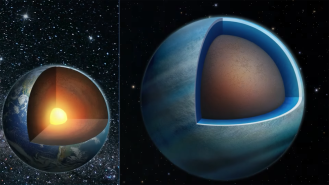Astronomers have just announced the discovery of what they believe are the first known examples of “water worlds.”
The background: In 2014, astronomers discovered three exoplanets orbiting Kepler-138, a star 218 light years from Earth. Two of the exoplanets — Kepler-138 c and Kepler-138 d — were slightly larger in diameter than our planet, which led to their classification as “super Earths.”
“We previously thought that planets that were a bit larger than Earth were big balls of metal and rock, like scaled-up versions of Earth, and that’s why we called them super-Earths,” said study co-author Björn Benneke from the University of Montreal.
University of Montréal astronomers have announced the discovery of what they believe are the first known examples of “water worlds.”
Despite their similar diameter, astronomers estimated that Kepler-138 c had a mass about twice that of Earth’s, while Kepler-138 d had a mass just .66 times Earth’s.
This estimate was based on a method called “transit-timing variation,” which involves tracking how the gravitational pulls of nearby exoplanets affect an observed planet as it passes in front of its star.
Water worlds: Benneke and his colleagues decided to conduct follow-up observations of Kepler-138 d using the Hubble and Spitzer space telescopes. The goal was to study its atmosphere, but the observations suggested the presence of another exoplanet orbiting the star: Kepler-138 e.
The researchers then recalculated the mass of the already-known exoplanets in the Kepler-138 system, taking into account the new exoplanet, and when they did, they determined that Kepler-138 c and Kepler-138 d are essentially “twins” with nearly the same mass and size.
Based on these newly calculated characteristics, the team believes that up to half of their volumes should be made of materials lighter than rock but heavier than hydrogen or helium — and water is the most common material that fits that criteria.
“[A] big fraction of their entire volume is likely composed of water,” said Benneke. “It is the best evidence yet for water worlds, a type of planet that was theorized by astronomers to exist for a long time.”
Steamed up: The closest comparisons we have to these water worlds are Europa and Enceladus — icy moons orbiting Jupiter and Saturn, respectively — but because Kepler-138 c and Kepler-138 d are so much closer to their star, their water would not be frozen.
“The temperature in Kepler-138 d’s atmosphere is likely above the boiling point of water, and we expect a thick dense atmosphere made of steam on this planet,” said lead researcher Caroline Piaulet.
“Only under that steam atmosphere there could potentially be liquid water at high pressure, or even water in another phase that occurs at high pressures, called a supercritical fluid,” she continued.
Eyes on the skies: Water wasn’t directly detected on these exoplanets, so it’s possible that their combination of volume and mass could be explained by some other, less common material.
Even if these twin exoplanets aren’t water worlds, though, we are now better equipped than ever before to find the theorized worlds, if they exist — researchers plan to study another candidate, the exoplanet TOI-1452 b, using NASA’s James Webb Space Telescope as soon as possible.
“As our instruments and techniques become sensitive enough to find and study planets that are farther from their stars, we might start finding a lot more water worlds like Kepler-138 c and d,” said Benneke.
We’d love to hear from you! If you have a comment about this article or if you have a tip for a future Freethink story, please email us at tips@freethink.com.
